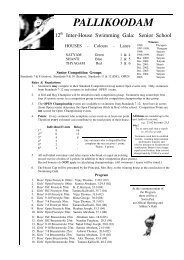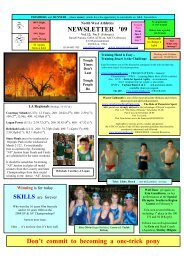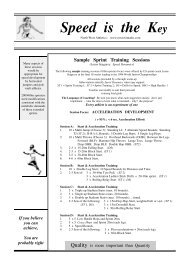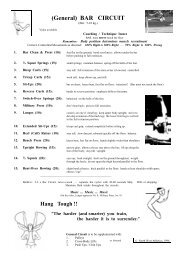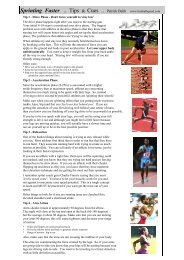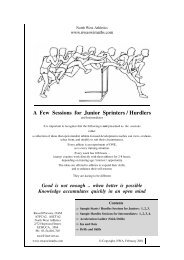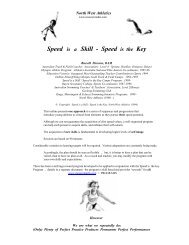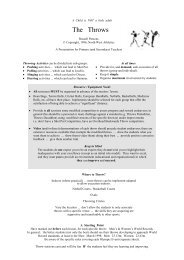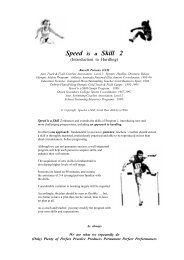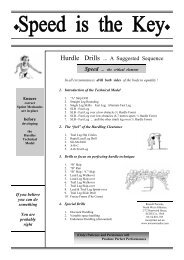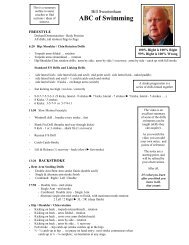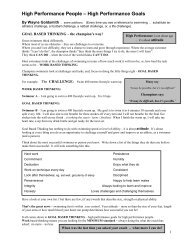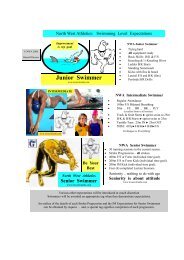Feeding Active Kids - Seoul Foreign School
Feeding Active Kids - Seoul Foreign School
Feeding Active Kids - Seoul Foreign School
Create successful ePaper yourself
Turn your PDF publications into a flip-book with our unique Google optimized e-Paper software.
<strong>Feeding</strong> active kids<br />
A guide for parents,<br />
coaches and team managers<br />
The junior<br />
swimmer<br />
1
GETTING READY...<br />
Junior swimmers train and compete throughout the year<br />
so there are several important things to keep in mind<br />
when feeding your active child<br />
Optimising growth and development 4<br />
Including adequate iron and calcium in their daily diet 4<br />
The importance of carbohydrates 5<br />
The importance of protein 5<br />
Where dietary fat fits into a healthy diet 6<br />
The importance of snacks as part of a young basketballer’s diet 6<br />
Ensuring your child is drinking enough fluids 6<br />
Managing weight and body image issues 7<br />
GETTING SET...<br />
The night before a carnival 9<br />
On the day 10<br />
GO!<br />
CONTENTS<br />
At the pool or the beach 11<br />
Fluid intake during a carnival 12<br />
After training or a carnival 12<br />
The night after a big day of competition swimming 13<br />
HOT TIPS TO STAY COOL<br />
How to avoid overheating and ensure<br />
adequate fluid intake 14<br />
WARNING SIGNS FOR DEHYDRATION<br />
15<br />
RECOMMENDED READING 15<br />
RECOMMENDED WEB SITES 15<br />
CONTACTS FOR FURTHER INFORMATION 15<br />
Author:<br />
Design:<br />
Sports Photography:<br />
Food photography:<br />
Food styling:<br />
Printing:<br />
Ruth Logan<br />
The Art Brokers<br />
David Martinelli (xxxxxxxxxxxxxxxxxxxxxxxxxxxxxxxx<br />
xxxxxxxxxxxxxxxxxxxxxxxxxxxxxxxxxxxxxxxxxxxxxxs)<br />
Jack Sarafian<br />
Janet Lillie<br />
Four Colour Digital Pty Ltd<br />
© October 2001, Published in Australia by the Canned Food Information Service Inc.<br />
ABN 30 384 483 475 ISBN 1 877025 666<br />
2
“Encourage your junior<br />
swimmers to eat and drink<br />
well, feel great and perform<br />
to their best”<br />
It is important for them to develop a<br />
healthy relationship with food and an<br />
appreciation of how dietary intake<br />
affects their performance, from an early<br />
age.<br />
This booklet offers guidance for meeting<br />
the nutritional needs of children aged<br />
5-11 who swim competitively, in the pool<br />
or the surf.<br />
Parents and coaches frequently ask me “What<br />
are the best foods and drinks for kids to have<br />
while playing sport. Just as often, in conversations<br />
between parents at sporting events, I<br />
hear quite different opinions being expressed<br />
about what is good and bad practice in watering<br />
and feeding our sports stars of tomorrow.<br />
Obviously many people are seeking answers<br />
to some simple but important questions.<br />
So it was very pleasing when the Canned<br />
Food Information Service asked me exactly<br />
the same sorts of questions because they<br />
wanted to know which of their products were<br />
appropriate for these active kids before,<br />
during and after sport.<br />
To answer these questions, we developed this<br />
booklet and the accompanying cookbook Fast<br />
Food for <strong>Active</strong> Families. I developed most of<br />
the recipes for the cookbook and tested them<br />
on our three “guinea pigs” and their multitude<br />
of friends, who gather round the kitchen<br />
bench on the weekends after sport.<br />
As the mother of three active primary school<br />
age children, this is a subject dear to my heart.<br />
I know how hard it is to juggle the demands of<br />
daily living whilst trying to maximise the<br />
family health and energy levels so that everyone<br />
performs at their best.<br />
As a Sports Dietitian, I know that elite athletes<br />
are well catered for in terms of professional<br />
advice on diet and training. But the<br />
parents of younger children, particularly in<br />
their first few years of competition, often have<br />
to rely on the advice of well-meaning volunteer<br />
coaches. And sometimes that advice can<br />
be misleading or incomplete.<br />
I am really pleased to have the opportunity to<br />
provide a service that fills this important gap and<br />
complements the work of other sports dietitians<br />
working with Australian athletes. The earlier<br />
healthy habits are established the better.<br />
I’d like to offer particular thanks to my colleagues<br />
Karen Inge and Lorna Garden, leading Australian<br />
Sports Dietitians currently consulting with the<br />
Australian Youth Swim Team, for their support<br />
and professional review of this publication.<br />
Also, thanks to my editorial team: Kerry Burkitt,<br />
Trish Lear and Grahame Horsfield.<br />
Ruth Logan BSc, Grad Dip Nut & Diet (SA), APD.<br />
Ruth is a member of Sports Dietitians Australia and<br />
Dietitians Association of Australia<br />
Ruth Logan with her three sporty kids<br />
(photography by Tony Coonan)<br />
3
GETTING<br />
READY...<br />
Junior swimmers train and compete<br />
continuously throughout the year. The<br />
busy competitive season is generally<br />
from September through to April,<br />
however many will train for the majority<br />
of the year so there are several important<br />
things to keep in mind when feeding your<br />
active child.<br />
These include:<br />
● optimising their growth and development<br />
year round<br />
● including adequate iron and calcium in their<br />
daily diet<br />
● including adequate carbohydrate and protein<br />
and suitable fat in their diet lproviding<br />
quick healthy low fat meals and snacks to<br />
maintain energy levels<br />
● ensuring sufficient liquid intake<br />
● being aware of possible weight and body<br />
image issues in your child.<br />
Optimising growth and development<br />
It is important for the junior swimmer to eat<br />
well every day — not just before a major<br />
competition or carnival.<br />
<strong>Active</strong> children need constant refuelling and<br />
cooling. Their nutrition needs are of great<br />
importance to their overall health, growth<br />
and development as well as to their sporting<br />
performance.<br />
The junior swimmer will perform better, over<br />
more events and recover quicker from training<br />
and carnivals when well nourished. Junior<br />
swimmers not getting enough total energy<br />
may become tired, irritable and lethargic, and<br />
may even struggle to maintain interest and<br />
enjoyment in sport. They can also become<br />
disappointed by poor times and performances<br />
after putting in many hours of hard training.<br />
It is important that active children learn to eat<br />
according to their appetite — ensuring they eat<br />
enough but not too much, while remembering<br />
they often have great variance in their appetite<br />
from day to day due to factors such as activity,<br />
tiredness and growth.<br />
The whole family may need to get organised<br />
for healthy eating — this can offer a great<br />
opportunity to change everyone’s food and<br />
fluid intake habits. Remember though, that the<br />
age and activity level of family members and<br />
friends will determine their required quantities.<br />
Iron and calcium are essential nutrients<br />
and especially important for young<br />
female swimmers<br />
Iron<br />
This mineral is responsible for carrying oxygen<br />
round the body and is essential for maximising<br />
energy levels in active children and adults. Low<br />
iron levels can cause tiredness and will affect<br />
performance at training and during competition.<br />
The best sources of dietary iron include lean<br />
red meats, liver and kidney. You should try to<br />
include a small amount of lean red meat in their<br />
diet at least 3-4 times weekly.<br />
Other sources of iron are green leafy vegetables,<br />
legumes such as lentils and baked beans,<br />
eggs and breakfast cereals. It is more difficult<br />
for the body to absorb the iron from these<br />
sources, so encourage children to eat complementary<br />
foods that supply Vitamin C. Adding<br />
Vitamin C increases the body’s ability to absorb<br />
the iron from non-meat sources. For example,<br />
put strawberries on the cereal or offer a glass of<br />
orange juice with the baked beans.<br />
Calcium<br />
Calcium is the mineral responsible for healthy<br />
growth and development of bones. It also helps<br />
to keep the muscles working properly. A lack of<br />
calcium can lead to weak bones and increased<br />
risk of fractures in later life.<br />
<strong>Active</strong> children should be encouraged to<br />
consume at least 2-3 serves of dairy foods or<br />
fortified soy alternatives each day. Examples of<br />
one serve include: 1 cup of reduced fat milk;<br />
1 tub of yogurt; 2 slices of reduced fat cheese;<br />
1 cup of a calcium enriched soy beverage.<br />
Other good sources of calcium include canned<br />
fish with edible bones, green leafy vegetables,<br />
nuts and seeds. But kids would need to eat<br />
quite large amounts of any of these choices to<br />
obtain a sufficient intake.<br />
4
The importance of carbohydrates<br />
Carbohydrates keep blood sugar levels constant,<br />
aid concentration during the day and help to<br />
keep these kids alert at school. Because the body<br />
can only store a limited amount of carbohydrate<br />
it is important to have at least one of these foods<br />
at every meal or snack to top up supplies.<br />
Elite junior swimmers are often required to train<br />
for up to four hours daily over two sessions,<br />
with recovery time between sessions spent at<br />
school. This places an enormous strain on their<br />
reserves of energy so it becomes very important<br />
to ensure they have frequent opportunities to eat<br />
foods rich in carbohydrate such as bread and<br />
other cereal products, fruit, and calcium rich<br />
dairy foods. These Getting Ready Foods, listed<br />
below, need to be eaten at frequent intervals<br />
each day as they provide much of the fuel<br />
needed to keep kids active, happy and alert at<br />
school.<br />
Often breakfast is eaten either on the pool deck<br />
or on the way to school if there’s not enough<br />
time to get home. Be prepared by using quick<br />
and easy breakfast foods. It is very important<br />
that your child’s school lunch box is well<br />
stocked with nutrient rich, high energy foods to<br />
allow them to fuel up ready for their afternoon<br />
training session. Also. remind them to keep up<br />
their intake of fluids during the day. I suggest<br />
using two lunch boxes for older kids to allow<br />
room for an afternoon snack to eat before<br />
training.<br />
Also, remember to encourage healthy dental<br />
hygiene habits to minimise the risk of tooth<br />
decay when consuming sweet carbos.<br />
The importance of protein<br />
As well as eating and enjoying a wide variety of<br />
foods, it is important to make sure that young<br />
swimmers have enough protein in their diet.<br />
Protein is found in both plant and animal foods<br />
and is necessary to provide the building blocks<br />
for growth in children. Its other functions are to<br />
repair any wear and tear on the body and help<br />
keep the immune system healthy and able to<br />
fight infection. Protein can also be used as fuel<br />
during activity. <strong>Active</strong> children may need<br />
slightly more protein than those who are less<br />
active but it is generally easy for them to eat<br />
enough by having some meat and dairy foods or<br />
selected protein rich vegetarian foods each day.<br />
Encourage them to include the Grow Foods<br />
listed (page6).<br />
Getting Ready Foods<br />
Cereals<br />
Breakfast cereals; rolled oats and other grains served hot or cold;<br />
Bread & bread rolls; pita, Turkish and mountain breads; tortillas, tacos, lavash; crackers & crisp<br />
breads; rice cakes; corn thins; rice; pasta ( including canned spaghetti); noodles; couscous<br />
Dairy & soy foods<br />
Plain & flavoured milks; yogurt; milk desserts<br />
Calcium enriched soy alternatives<br />
Fruit<br />
All fresh, canned or dried fruits; fruit bars; fruit fingers; fruit juices<br />
Vegetables & legumes (pulses)<br />
Potato, sweet corn, sweet potato, peas, beetroot, pumpkin, baked beans, lentils, chick peas, soy<br />
beans, bean mixes<br />
Extras - sweet snacks<br />
Low fat cereal/muesli bars; muffins; cake; biscuits; fruit buns, fruit loaf, fruit scones; pikelets,<br />
pancakes, waffles; jelly confectionery, jelly, jellied fruits; sports drinks, cordial<br />
5
Meat, seafood and eggs<br />
Beef, veal, lamb, pork, turkey, chicken<br />
Fish - fresh, canned or frozen; other seafood<br />
Eggs<br />
Dairy and soy foods<br />
Milk, cheese and yogurt<br />
Calcium enriched soy products - milk, yogurt<br />
Tofu<br />
Grow Foods<br />
Legumes, nuts and seeds<br />
Baked beans; meat analogues (vegetarian foods); seed beans; nuts such as almonds and<br />
cashews; peanuts and peanut butter; seeds like pumpkin and sunflower<br />
Where dietary fat fits into a healthy diet<br />
All children require a small amount of fat (3-4<br />
teaspoons) in their daily food intake for normal<br />
growth and development. It is recommended<br />
that all Australians, including children, limit<br />
their intake of saturated fats (mainly animal<br />
fats but also commonly found in processed<br />
foods). Children, however, need to include<br />
plenty of the healthier unsaturated fats found in<br />
foods like fish, nuts, seeds and avocados.<br />
Children under the age of five need to be eating<br />
full cream dairy foods to meet their nutritional<br />
and energy needs. However, children over five<br />
years of age may be offered reduced fat dairy<br />
products.<br />
The importance of snacks as part of a<br />
young swimmer’s diet<br />
Sometimes a snack might be all a child can<br />
manage to eat when feeling tired or too busy or<br />
excited for anything else. It has been found that<br />
snacks contribute significantly to a child’s daily<br />
food intake and therefore it’s very important to<br />
include healthy choices.<br />
Encourage ‘active’ recovery between training<br />
sessions and between events at carnivals by<br />
providing foods and drinks containing plenty of<br />
carbohydrate. Often fluids are more acceptable<br />
to children at this time with the best choices<br />
being sports drink, cordial, fruit juice and<br />
flavoured milk. Further tips on how to manage<br />
carnival days are included on page 10.<br />
When time permits it is a great idea to include<br />
recovery foods containing a small amount of<br />
protein with the carbohydrate. Try snack packs<br />
of canned fruit or fruit purees with yogurt,<br />
baked beans or spaghetti with cheese on toast,<br />
cereal bars or fruit bars with a milk drink.<br />
For more suggestions see Smart Snacks<br />
(page 7 ), and Energy Boosters (page 11).<br />
‘Treat’ foods do have a role to play in a healthy<br />
diet but encourage children to recognise treats<br />
as occasional, not every day. Discourage excess<br />
indulgences by explaining to kids that too much<br />
of anything can create problems and will<br />
certainly affect their ability to perform to their<br />
best.<br />
Before and after training sessions is a great<br />
time to offer an occasional “sweet treat” to top<br />
up energy levels. These include sports drinks,<br />
cordials, jelly and jelly confectionery.<br />
6
Smart Snacks<br />
Quick Picks<br />
Bread, crumpets or English muffins with<br />
spread<br />
Fresh fruit or a snack pack of canned fruit<br />
Vegetable pieces with low fat dip<br />
Scone, pikelet or pancake with syrup or jam<br />
Canned spaghetti on toast<br />
Baked Bean sandwich<br />
Fruit bun or raisin toast with spread<br />
Low fat, quick cook noodles or pasta snacks<br />
Fresh or canned fruit salad with yogurt<br />
Low fat yogurt<br />
Low fat cereal/fruit bars<br />
Home made popcorn<br />
Pita chips, pretzels or crackers<br />
Corn & rice crackers or corn thins<br />
Low fat smoothie with fruit (fresh or canned)<br />
Low fat milkshakes or fruit spiders made<br />
with canned fruit<br />
High fibre crackers with reduced fat cheese<br />
and salad<br />
Breakfast cereal with milk and canned or<br />
fresh fruit<br />
Low fat fruit muffins or slice<br />
Hunger Busters<br />
Leftover Pizza Power<br />
Hunger Buster Burgers<br />
Chicken Wraps<br />
Mince Muffins<br />
Pinwheels<br />
Savoury Muffins<br />
Potato Fritters<br />
Rolls, bagels, sandwiches, wraps or pita<br />
pockets filled with:<br />
cold meat (chicken, ham, canned fish, beef,<br />
turkey) and/or egg, cheese and fresh salad<br />
Jaffle or toasted sandwich filled with:<br />
Savoury Mince; cheese and sweet corn;<br />
snack size cans of prepared meals with<br />
cheese or tomato; chicken, mayonnaise,<br />
sprouts and cheese; tuna, tomato and<br />
cheese; can of chilli beans, tomato and<br />
cheese; salmon, salad and creamed cheese;<br />
baked beans and cheese; canned spaghetti<br />
Apple Crunch and custard<br />
Aussie Peach Dream<br />
Tropical Rice Delight<br />
Ensuring your child is drinking enough<br />
fluids<br />
Managing liquid intake is just as important as<br />
their food intake. Getting these young people<br />
into the habit of taking regular fluids is extremely<br />
important. Dehydration is a common<br />
problem within this group of junior athletes<br />
especially when swimming in heated indoor<br />
pools or outdoors in the heat of summer, and it<br />
is often not well recognised.<br />
Remind children to keep up their fluid intake by<br />
drinking ‘mouthfuls often’ before and during<br />
training and immediately after each event, when<br />
at carnivals, as well as during the day at school<br />
or home. Water is the preferred drink but during<br />
activity a flavoured sports drink containing<br />
small amounts of sugar and electrolytes may<br />
encourage greater intake and provide an energy<br />
boost.<br />
Managing weight and body image issues<br />
in your child<br />
Junior swimmers (and their coaches) may<br />
become concerned about their body weight due<br />
to changes related to growth phases. Children<br />
grow in ‘spurts’ – usually going out first,<br />
followed by an upward growth phase. During<br />
this ‘out’ phase, children often become very<br />
aware of their body shape and dislike the<br />
associated feeling or appearance of fatness.<br />
This can become even more obvious to swimmers<br />
due to their need to wear minimal<br />
amounts of clothing when participating in their<br />
chosen sport. Coaches and parents need to be<br />
7
aware of their sensitivity to weight related<br />
comments and always encourage healthy food<br />
choices without severe restriction of quantity.<br />
Deprivation of food intake can lead to nutritional<br />
insufficiency, poor growth and long term<br />
problems with disordered eating habits.<br />
There are always going to be some junior<br />
swimmers who are more prone to problems<br />
with weight control while there will also be the<br />
naturally lightly built participant who struggles<br />
to eat enough food and requires constant<br />
encouragement with food and fluid intake to<br />
maintain adequate energy for their sport.<br />
It will be important to encourage those children<br />
on the light side to eat something at times when<br />
they feel too tired or busy to bother. But don’t<br />
panic if their appetite sometimes seems less<br />
than usual – that’s normal! This is why eating<br />
healthy snacks is so important. Growing junior<br />
swimmers can have voracious appetites so be<br />
prepared by having plenty of nourishing quick<br />
snack foods available that are filling and<br />
satisfying.<br />
For those junior swimmers wanting to gain<br />
weight or strength the advice is quite simple –<br />
eat larger quantities of nutritious foods, and<br />
healthy snacks like nuts and dried fruit, and<br />
enjoy more nourishing drinks to provide the<br />
extra energy required to build muscle. Children<br />
with medical concerns such asthma are often<br />
encouraged to take up swimming. They may be<br />
in the habit of eating a special diet to help<br />
relieve their symptoms. It is important that they<br />
are not restricting or avoiding food groups<br />
unnecessarily as this could lead to nutritional<br />
imbalance.<br />
As both boys and girls are involved in swimming,<br />
it is important for them to develop a<br />
healthy attitude to food and body image. As<br />
discussed, the nutrients of particular concern to<br />
young female swimmers are iron and calcium.<br />
Ensure girls have a regular intake of foods<br />
which are rich sources of these nutrients.<br />
It is important to also be aware of eating issues<br />
and be alert to their sensitivity about weight<br />
management issues. I sometimes find young fit,<br />
healthy girls and boys being unnecessarily<br />
worried about their size and shape.<br />
It is a good idea to encourage all children to<br />
become actively involved with the purchase<br />
and preparation of healthy meals and snacks<br />
early in life. This helps to develop a healthy<br />
relationship between the athlete, their food and<br />
their bodies.<br />
If your child is overweight, a healthy diet<br />
and activity plan will help<br />
Management of overweight children often<br />
requires expert help from your doctor or a<br />
dietitian. Avoid strict dieting or rapid weight<br />
loss. These children have a huge potential for<br />
growth which aids weight control by allowing<br />
them to “grow into their weight”. Parents can<br />
help by reducing the child’s overall energy<br />
intake and encouraging more physical activity.<br />
Choose low fat foods for meals and snacks,<br />
avoid the use of fatty take away and convenience<br />
foods and replace high sugar snacks and<br />
drinks with water and more nutritious choices<br />
like fruit. Beware of ‘boredom eating’ during<br />
carnivals if your child is in only a few events<br />
and so spends lots of time sitting and waiting<br />
for their turn to swim.<br />
Healthy eating is the same for overweight and<br />
normal weight active children, although the<br />
amounts consumed might need to be different.<br />
Fatty, salty snacks should be minimised for<br />
everyone and replaced by some of the Smart<br />
Snacks (page 7).<br />
In swimming there are plenty of opportunities<br />
for the ‘bigger’ child to enjoy participating. But<br />
even so they will enjoy their sport more when<br />
they feel fitter and carry less body weight.<br />
If appropriate, use of one of their favourite<br />
swimming heroes as a good example of health<br />
and fitness. You can tell them that their idols<br />
eat what is recommended here.<br />
8
GETTING SET...<br />
The night before a carnival<br />
The night before a big sporting event requires<br />
extra effort to ensure sufficient carbohydrate is<br />
eaten and enough fluids have been consumed to<br />
ensure a good state of hydration. Often this<br />
happens on a Friday or Saturday night when<br />
busy families are pushed for time and spare<br />
energy.<br />
If so, keep the food simple and use convenient<br />
canned and frozen foods and packaged foods<br />
like noodles, pasta and rice to supplement fresh<br />
products to produce healthy fitness foods, fast.<br />
Thinking ahead and having foods pre-prepared<br />
will ease the pressure and help the family<br />
achieve a great performance all round. This is<br />
the time for carbohydrates, some protein foods<br />
and plenty of nourishing drinks. (Remind the<br />
children that these are the same foods the sports<br />
stars they admire eat the night before a big<br />
race.)<br />
You’ll find many family favourites are ideal<br />
including some of the recipes from the cookbook<br />
Fast Food for <strong>Active</strong> Families. If you<br />
don’t have this cookbook you can call<br />
1800 033 872 to obtain a free copy. Recipes<br />
included from our cookbook are listed in italics.<br />
Healthy Family Fast Food<br />
Family main meal ideas<br />
Logan’s Lasagne - rich with beef, pork or chicken, tomatoes, frozen spinach & cheese<br />
Performance Pasta - your favourite pasta shape with bacon, vegetables and cheese<br />
Mexi Balls - beef, rice and tasty seasoning turned into yummy meatballs<br />
Sweet Lamb Curry - luscious lamb and vegetables in a rich but mild curry sauce<br />
Mince in Minutes Tacos - use our quick mince recipe to turn into tasty tacos<br />
Hunger Buster Burgers - juicy quick steaks with beetroot, pineapple and cheese in a roll<br />
Winter Casserole - a classic but quick rich beef casserole with bacon, tomatoes and mushrooms<br />
Chicken Wraps - tortillas filled with roast chicken, canned beans, salad and light sour cream<br />
Hearty Minestrone - a meal in a bowl rich with vegetables, beans and rice<br />
Pinwheels - savoury spiral buns filled with tasty mince, herbs and cheese<br />
Pizza Power - uses a prepared base topped with roast chicken, ham, pineapple and cheese<br />
Spinach, Feta and Corn Pie - a delicious ‘loaf’ to serve with salsa or your choice of sauce<br />
Pineapple Chicken Stirfry - chicken with fruit and vegetables in a spicy but sweet sauce<br />
Desserts and ‘extras’<br />
Apple crunch<br />
Tropical Rice Pudding<br />
Aussie Peach Dream<br />
Fruit Salad Anzac Slice<br />
Pancakes or waffles<br />
Creamed rice with canned fruit<br />
Canned fruit with custard or ice cream<br />
Fresh rolls, a salad or a fruit platter<br />
Drinks<br />
Speedy shake<br />
Fruit Spider<br />
Peach & Mango Smoothie<br />
Milk drinks<br />
Fruit juices and cordials<br />
9
On the day<br />
No matter what time your child has their first<br />
‘swim’, breakfast is always an important meal.<br />
See the Breakfast Ideas listed below.<br />
Breakfast, or any main meal, should ideally be<br />
eaten at least two hours before the warm up<br />
period or their first event, to keep your child<br />
feeling satisfied and well fuelled. But if your<br />
child is hungry close to their swim time, a<br />
small low-fat snack eaten up to one hour prior<br />
to activity should not cause them any digestive<br />
problems while swiming. Experiment with<br />
foods during training times to ensure the food<br />
chosen does not cause any gastrointestinal<br />
upset or discomfort.<br />
Breakfast Ideas<br />
Cereal with fat reduced milk , fruit and<br />
yogurt plus glass of juice<br />
Toast with a scrape of butter or<br />
margarine, fat reduced cheese and<br />
tomato with a glass of milk<br />
Spaghetti on toast with a fruit milkshake<br />
Scrambled egg with cheese and tomato,<br />
toast and a glass of juice<br />
Banana and peanut butter on toast with a<br />
flavoured milk drink<br />
Baked beans with fat reduced grated<br />
cheese on toast with fruit and a glass<br />
of milk<br />
Canned spaghetti on toast, yogurt and a<br />
glass of fruit juice<br />
Canned fruit with yogurt; toast and<br />
spread with a glass of milk<br />
Fruit or English muffins with a scrape of<br />
spread and honey or jam and a fruit<br />
smoothie<br />
Pancakes with honey and a glass of milk<br />
Crumpets with honey, a tub of yogurt<br />
and a glass of flavoured milk or juice<br />
If your swimmer trains in the afternoon or has<br />
an evening competition/club meet, provide a<br />
nourishing snack prior to the start of their<br />
activity and have a quick and easy meal ready<br />
for when they get home.<br />
The timing of carnival events is variable so it is<br />
important to learn how to time your child’s<br />
food and fluid intake according to their particular<br />
events. This might take time and experimentation<br />
to find what suits each individual, but<br />
you can use the following as a guide:<br />
Coping with Carnivals<br />
No time between events:<br />
A sports drink only.<br />
Limited time - less than 1 hour between<br />
events:<br />
Take fluids – sports drink and water are<br />
important to include for hydration and an<br />
energy top up. A very small amount of a low<br />
fat snack food may be included if hungry.<br />
Choose glucose confectionery; fruit (fresh,<br />
canned or dried) or a fruit bar; crackers.<br />
Plenty of time - 1-2 hours between events:<br />
Include fluids – water, sports drink, fruit<br />
juice, smoothie, liquid meal. Avoid soft drinks<br />
with gaseous bubbles. Choose snacks as for a<br />
limited time event but add grain/fruit type<br />
bars; sandwich; rice or pasta salad; scone or<br />
pikelet.<br />
Longer than 2 hours between events:<br />
Include a more substantial snack or a light<br />
meal – (see Smart Snacks on page 7). Between<br />
morning heats and evening finals is a good<br />
time to include the main meal for the day.<br />
Often the night meal will be late and a lighter<br />
snack with plenty of nourishing fluids will be<br />
best at that time.<br />
If you have to travel long distances or need to<br />
make an early start before a carnival, pack some<br />
breakfast-on-the-run foods including flavoured<br />
milk drinks; cereal bars; bread rolls with spread;<br />
juice; fruit bars; canned or fresh fruit or a fruit<br />
bun. Or use a prepared liquid meal to allow your<br />
swimmer to eat at a more suitable time.<br />
The best foods to serve for their ‘pre-event’<br />
meals are those your children are used to eating<br />
and are quick and easy to prepare and eat –<br />
minimise fuss.<br />
Low fibre foods, like nourishing drinks, could<br />
be best for for these meals if your child gets an<br />
upset tummy due to ‘nerves’ before competition.<br />
Otherwise foods that are rich sources of carbohydrate,<br />
yet low in fat, are best eaten at the preevent<br />
meal.<br />
Remember to encourage your children to drink<br />
fluids at this time. The best drinks to offer are<br />
low fat milk, juice, and plenty of water. One to<br />
two cups should be enough.<br />
10
GO!<br />
At the pool or the beach<br />
It is important to be flexible with food choices,<br />
as the best food for your child to have will<br />
depend on the timing of their events and what<br />
foods they find that suits them. I have often<br />
overheard children complaining of hunger at<br />
carnivals and their parents are unsure what to<br />
give them. Use the guide provided on page 11 to<br />
prepare an eating and drinking plan for their day<br />
and organize suitable foods to take with you.<br />
Don’t rely on the canteen or vending machines<br />
to supply suitable snacks and drinks on<br />
carnival days, as healthy choices are not always<br />
available.<br />
Be prepared by taking your own snack and<br />
drinks supply. If your child is competing in an<br />
all day competition pack up a supply of suitable<br />
snacks and drinks in an esky or cooler bag.<br />
Don’t forget a good supply of sunscreen if<br />
swimming outdoors.<br />
Always pack two drink bottles per child – one<br />
for water and the other with sports drink.<br />
Also take a top up supply of cooled water, juice<br />
poppers and flavoured fluids if it will be a long<br />
day.<br />
More snack ideas suitable to eat during longer<br />
breaks on carnival days include the<br />
Energy Boosters in the next column. Each snack<br />
contains about 40-50 g of carbohydrate and<br />
will help boost energy levels and prevent hunger<br />
for active kids.<br />
It’s always a good idea to encourage some solid<br />
food with fluids, if time permits, between races.<br />
Energy Boosters<br />
Flavoured milk or a liquid meal tetrapak<br />
(e.g.Sustagen)<br />
1 bottle (600 mL) sports drink or<br />
prepared sports cordial<br />
A snack pack of canned fruit with a juice<br />
popper<br />
50 g packet of jelly confectionery with<br />
water<br />
Jam or honey sandwich with a juice<br />
popper<br />
1 piece of fruit or 1 packet sultanas with<br />
300 mL sports cordial<br />
Bread roll with banana and water<br />
1 low fat cereal bar with a juice popper<br />
or flavoured milk<br />
1 fruit bun with a juice popper<br />
2 large pikelets with jam or honey plus a<br />
snack pack of canned fruit<br />
Fruit muffin with a juice popper or water<br />
11
Fluid intake during a<br />
carnival<br />
In the time between their warm up and their<br />
first race, aim to get your child to drink some<br />
water or sports drink.– about a cup would be a<br />
good amount.<br />
Remember to encourage fluid intake during<br />
breaks between their races. Aim to get kids<br />
drinking at least 1 /2 a cup from their drink<br />
bottles. This equates to at least a couple of<br />
‘good mouthfuls’ immediately after they race.<br />
The swimmers will be working hard and need<br />
to top up with food and fluids to keep performing<br />
at their best.<br />
Some swimmers will obviously need more<br />
fluids than others; so keep a check on how they<br />
are all feeling. If they are starting to look or<br />
feel hot, push the fluids a little more.<br />
Seasonal variation and the change in environmental<br />
conditions will influence the volume of<br />
fluid that active children require. They will<br />
need to be reminded to drink more frequently<br />
when the weather is warm. As winter creeps in,<br />
you might expect their fluid losses to lessen but<br />
it is even more important to remind them to<br />
drink, as they often won’t feel thirsty despite<br />
being dehydrated especially when swimming in<br />
heated pools. Immediately after their training<br />
session or at the end of their carnival encourage<br />
kids to drink the rest of their bottle (at least 500<br />
mL). Sports drinks and water are best during<br />
and after a hectic session of activity and are<br />
especially important during a competition day.<br />
Sports drinks and sports cordials have been<br />
proven to be useful in recovery as they assist<br />
fluid and electrolyte replacement. Also, it has<br />
been shown that children will drink more if the<br />
fluid is flavoured – vary the flavours to avoid<br />
taste fatigue.<br />
Many young Aussies spend the summer months<br />
training and competing in surf life saving<br />
carnivals. The nutrition issues of concern to<br />
this group of junior swimmers, the “Nippers”<br />
are similar to those of swimmers who spend all<br />
their time at the pool. Of course the problems<br />
of sun exposure and dehydration are high risk<br />
and need constant care and attention on carnival<br />
days. Always pack a generous supply of<br />
cool drinks and plenty of sunscreen along with<br />
some healthy snacks to keep them going during<br />
their strenuous day of activity. Also encourage<br />
them to look for some shade to sit under during<br />
periods of inactivity.<br />
After training or a carnival<br />
Recovery after each training session or a<br />
carnival day is essential to maintain your<br />
child’s best performance – especially if they<br />
are training twice daily or at a major swim<br />
meet which continues for several days like the<br />
State Titles or Age Nationals.<br />
Recovery snacks and fluids should be<br />
● started within 30 minutes of finishing<br />
exercise<br />
● high in carbohydrate with a little protein<br />
● quick and easy to prepare and eat<br />
● available at the venue if it takes a long time<br />
to get home.<br />
Junior swimmers training on cold, bleak winter<br />
mornings often look for something warm to eat<br />
after their early session. Porridge is a great<br />
warming snack and other winter-warming,<br />
nourishing ideas can be found in Smart Snacks<br />
(page 7).<br />
In the warmer months these active kids may<br />
feel more like a refreshing drink or cooling<br />
snack after a hard training session, so you’ll<br />
also find some summery meal and snack<br />
suggestions amongst the Smart Snacks.<br />
12
The night after a big day of<br />
competition swimming<br />
Coping with tired, hungry junior swimmers at<br />
the end of a long day can be challenging for<br />
any parent. The temptation to line up at a fast<br />
food outlet can be great and pressure from the<br />
children can make it even harder to resist.<br />
Of course, takeaway foods can be enjoyed as<br />
an occasional treat but generally try to limit to<br />
special occasions rather than every weekend!<br />
You may not be in the habit of having a meal<br />
ready at home but with the help of some ideas<br />
from the cookbook and remembering to use<br />
‘convenience foods’ from the supermarket, it<br />
will be possible! It will also save the family<br />
time and money and certainly improve the<br />
nutritional value of the meal.<br />
One solution is to have food already prepared<br />
in the fridge or freezer – only needing reheating<br />
when you get home.<br />
Have a selection of fresh, canned, packaged<br />
and frozen foods on hand to prepare home<br />
cooked ‘Fast Food’. You will find the following<br />
quick and easy to prepare recipes in Fast<br />
Food for <strong>Active</strong> Families as well as some<br />
suitable to prepare in advance for a quick<br />
reheat when you get home.<br />
Quickly prepared dishes<br />
Mince in Minutes<br />
Pizza Power<br />
Tropical Toasted Fingers<br />
Savoury Fruit Rolls<br />
Chicken Wraps<br />
Spinach, Feta and Corn Pie<br />
Pineapple Chicken Stirfry<br />
Tropical Rice Delight<br />
Potato fritters<br />
Easy Chicken and Pasta<br />
Ideal for reheating<br />
Logan’s Lasagne<br />
Winter Casserole<br />
Sweet Lamb Curry<br />
Mexi Balls<br />
Quick Potato Bake<br />
Pumpkin Damper<br />
Potato Power<br />
Hearty Minestrone<br />
Pinwheels<br />
13
HOT TIPS TO<br />
STAY COOL<br />
How to avoid overheating<br />
and ensure adequate fluid<br />
intake<br />
Running out of fuel can be a problem for young<br />
swimmers doing many events, but getting<br />
overheated is also a very real possibility for<br />
these active kids and will impair their performance.<br />
● Children should always have their own<br />
water bottle on the pool deck to sip from<br />
during training and in a cooler bag to sip on<br />
during breaks on carnival days. Keep fluids<br />
cool. This can be a problem in both winter<br />
and summer depending on whether the pool<br />
is indoors or outdoors. And it is always a<br />
problem at surf events. <strong>Kids</strong> swimming in a<br />
heated pool can get quite hot and will be<br />
less tempted to drink warm fluids. Aim to<br />
have their drink bottle very cold or perhaps<br />
even partly frozen at the start of activity as<br />
it will get warm quite quickly in a hot,<br />
humid environment. Offer them a mix of<br />
water and flavoured drinks such as sports<br />
drink, or sports cordial, to encourage greater<br />
intake during and after activity.<br />
● Fluid loss will vary from one day to the next<br />
depending on many factors. Be prepared to<br />
compensate for extra losses if your child is<br />
overheating.<br />
● A quick way to estimate how much fluid a<br />
child needs during training can be achieved<br />
by checking their weight before and after a<br />
training session. The difference in their<br />
weight represents the volume of extra fluid<br />
required. I don’t suggest this be done every<br />
day but it may be useful if your child needs<br />
encouragement to drink more. Another<br />
quick guide of hydration is the colour of<br />
their urine. If they notice their urine is a<br />
darker colour than usual, it is a fair indicator<br />
of dehydration – they need to take extra<br />
drinks.<br />
● Junior swimmers can sometimes be reluctant<br />
to drink while training and competing.<br />
Persistent encouragement is probably the<br />
best way to overcome this problem until<br />
they get into the habit of keeping themselves<br />
adequately hydrated.<br />
●<br />
●<br />
●<br />
●<br />
●<br />
Remind children not to wait until they are<br />
thirsty before they start to drink! By then<br />
they will already be starting to dehydrate<br />
and possibly overheating.<br />
Discourage your swimmer from using<br />
carbonated drinks before, during and immediately<br />
after exercise as they can upset the<br />
stomach and reduce their desire to drink.<br />
(Bloating can be a problem and means they<br />
will get too full before they drink a sufficient<br />
volume.)<br />
It is not suitable for active children to be<br />
using high caffeine drinks before, during or<br />
after sport. Discourage intake of tea, coffee,<br />
cola drinks and the new age ‘energy’ drinks<br />
that contain large amounts of caffeine.<br />
These are definitely not recommended for<br />
junior athletes.<br />
Monitor drinks hygiene. Encourage your<br />
swimmer to adopt healthy habits when<br />
drinking from a shared bottle. It is preferred<br />
that kids get into the habit of taking their<br />
own bottle. But if they forget, their lips<br />
should not touch any part of a shared bottle.<br />
Teach them how to squirt or use a chin<br />
sipper bottle to get the water into their<br />
mouth.<br />
Sports drinks are an excellent source of<br />
energy and fluid during and after activity.<br />
But encourage your swimmer to drink<br />
flavoured fluids through a straw to direct the<br />
fluid to the back and avoid swishing round<br />
the mouth. This limits the amount of contact<br />
between the sports drink and teeth, helping<br />
reduce the risk of dental decay.<br />
14
WARNING<br />
SIGNS FOR<br />
DEHYDRATION<br />
Know the warning signs for dehydration. If a<br />
child shows any of the following signs it would<br />
be best for them to take some time out to rest<br />
and take in fluids<br />
● dizziness and light-headedness<br />
● muscle cramps<br />
● nausea and headache.<br />
After games you will know if your child has<br />
not drunk enough if any of these signs are<br />
noticed<br />
● dark urine and infrequent urination<br />
● dry mouth and throat<br />
● a feeling of extreme heat which remains<br />
after a cool down time.<br />
15



